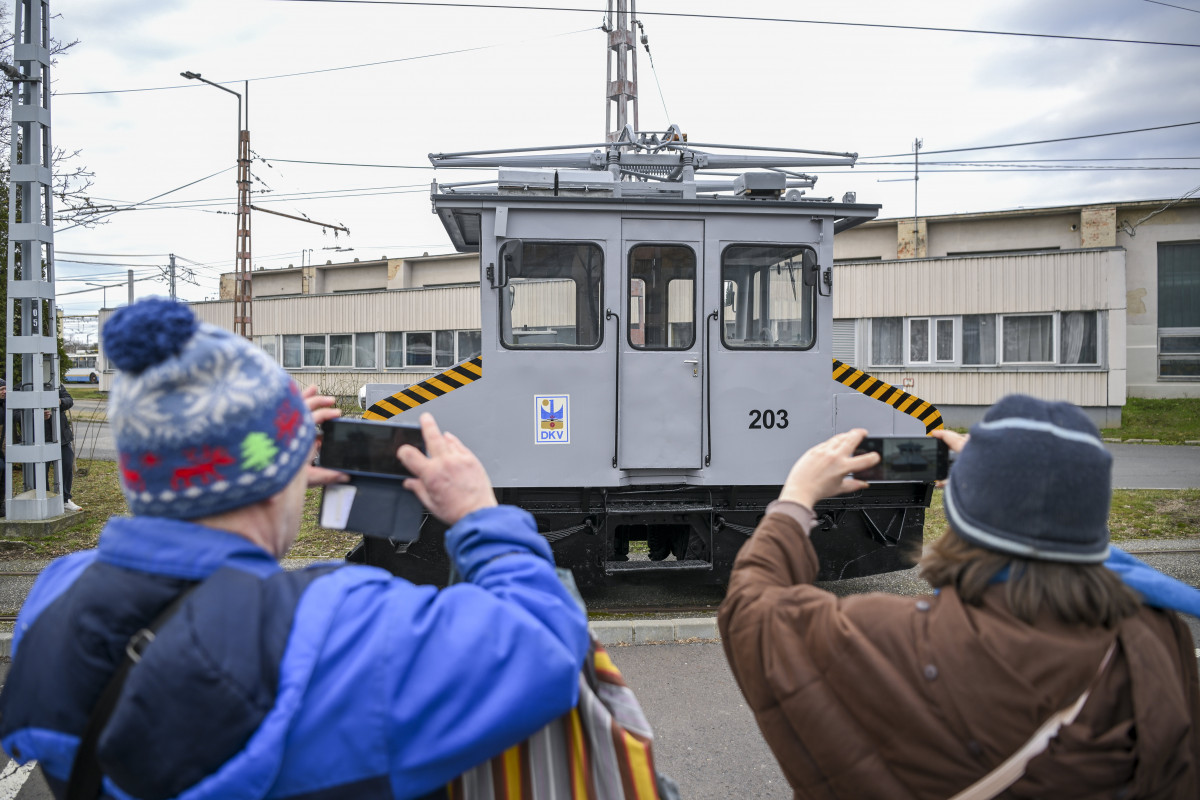The tram number 203, better known as the “frog”, was renovated by the enthusiastic and helpful employees of DKV Zrt. during the past months. The corroded plates, headlights and rear-view mirror were replaced on the assembly, the necessary carpentry work was performed, and the vehicle’s pantograph was renovated. The locomotive was repainted after priming, and the interior received new decorative elements, DKV announced.
History
The Budapest-Újpest-Rákospalotai Electric Railway Railway Company (BURV), founded by Ganz és Társa and the Magyar Ipar-és Kereskedelmi Bank Rt., started freight transport duties in the surrounding industrial estates on June 22, 1896. The railway bought a steam locomotive in 1895 and two electric locomotives a year later to handle freight traffic.
These electric locomotives are the first domestically produced, standard-gauge locomotives, which BURV took into stock with track numbers 1 and 2. The locomotives with a narrow driver’s position were called frogs because of their stubby shape.
The locomotive was originally only able to tow two freight cars, but the operating company already requested that two more freight cars could be connected to the train. At a speed of 20 km/h, the locomotive could transport a load of 34 tons. In order to tow the main railway cars, they were equipped with a MÁV system, central traction and stopping device. The locomotive, unlike the other vehicles owned by BURV, did not have an air brake, because the already low-powered locomotive would have had to be significantly modified for that. Furthermore, at that time two new modern locomotives were already being procured.
In 1923, the management of BURV was taken over by Budapest Székesfővárosi Közlekedesi Rt. (BSZKRT). The locomotive was first registered with the number M1, then in 1940 it received the number 7200.
In 1943, M1 and M2 were converted into twin locomotives, of which 7,200 were scrapped on July 26, 1951. The locomotive then moved to Debrecen, where the Debrecen Electric Railway (DVV) took it into service with track number 203.
In 1960, the “frog“ with track number 203 received a new chassis and running gear with rolling bearings. In 1997, it underwent renovation again. The plan was to sell it to the Transport Museum, but that fell through.
In the second half of the 1960s, DKV carried out the production and repair of FVV articulated trams, as well as the overhaul of BKV two-axle road and heat trailers. The vehicles arriving on high-speed rail cars were delivered to the area of the main workshop in Debrecen by locomotive 203 via the electrified industrial track connecting to the Debrecen Vásártér MÁV station.
The locomotive was placed under monument protection in July 2020, and the renovation of the cult vehicle began after that.
The 202 “frog“ locomotive
DVV already had a similar locomotive in 1951. The “frog“ with track number 202 was acquired by the Budapest Szent-Lőrinci Local Interest Tramway from the Ganz factory in 1900. In 1943, the BSZKRT sold the locomotive to Magyar Vasútforgalmi Rt., which first sent the locomotive to Nagyvárad, and then to Cívisváros after the air attack on Debrecen in 1944. During World War II, the locomotive also transported passengers on the Pallagi line with a trailer. “Frog“ 202 was scrapped in 1961.
The Pallag tram line was handed over a hundred years ago
The Hungarian Royal Academy of Economics was opened in Pallag in 1901, so it became necessary to build a transport line through which the students could approach the building. In November 1922, the Ministry of Trade convened a survey in which a proposal was made for the construction of the newly constructed tram line. In January 1923, a site visit was held in the construction area, and then negotiations began regarding the works and cost-sharing. The city of Debrecen has decided to provide the 226 wooden poles and 2,600 kg of copper wire required for the construction of the line, and also to bear 8 million kroner of the 21 million kroner initial cost. By the end of the year, the electrification of the Pallagi line was already in full swing. The Debrecen Local Railway set the fares: a one-way ticket from the Letter Csárda to the Academy costs 1,000 kroner, while a return ticket costs 1,800 kroner.
On February 2, 1924, the line was tested in working order. The length of the track was set at 5302 meters and the journey time at 45 minutes. The trams were assigned three or twelve route numbers, depending on whether they traveled from the Great Station or Fürdő to the final station. Different from other vehicles on the main line, a green light was placed at their ends. On February 18, i.e. exactly 1 year ago, the Pallag tram line was handed over, which operated until March 1, 1970, when the line was discontinued.
The data was collected and compiled by: Kálmán Gara, collection manager.
(MTI)
Pictures: MTI/Zsolt Czeglédi



















